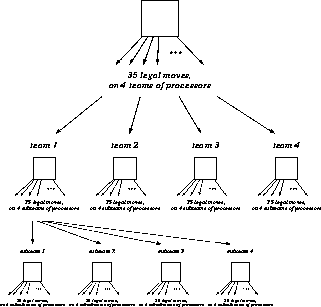




Next: Analysis of Alpha-Beta
Up: 14.3 Computer Chess
Previous: 14.3.2 Parallel Computer Chess:
Some good chess programs do run in parallel (see [Finkel:82a],
[Marsland:84a], [Newborn:85a], [Schaeffer:84a;86a]),
but before our work
nobody had tried more than about 15 processors. We were interested in
using hundreds or thousands of processors. This forced us to squarely
face all the issues of parallel chess-algorithms which work for a few
processors do not necessarily scale up to hundreds of processors. An
example of this is the occurrence of sequential bottlenecks in the control structure of the program. We have been very
careful to keep control of the program decentralized so as to avoid
these bottlenecks.
The parallelism comes from searching different parts of the chess tree
at the same time. Processors are organized in a hierarchy with one
master processor controlling several teams, each submaster controlling
several subteams, and so on. The basic parallel operation consists of
one master coming to a node in the chess tree, and assigning subtrees
to his slaves in a self-scheduled way. Figure 14.5 shows a
timeline of how this might happen with three subteams. Self-scheduling
by the slaves helps to load-balance the computation, as can be seen in
the figure.
So far, we have defined what happens when a master processor reaches a node
of the chess tree. Clearly, this process can be repeated recursively. That
is, each subteam can split into sub-subteams at some lower level in the tree.
This recursive splitting process, illustrated in Figure 14.6,
allows large numbers of processors to come into play.
In conflict with this is the inherent sequential model of the standard
alpha-beta algorithm. Pruning depends on fully searching one subtree in
order to establish bounds (on the score) for the search of the next subtree.
If one adheres to the standard algorithm in an overly strict manner, there
may be little opportunity for parallelism. On the other hand, if one is too
naive in the design of a parallel algorithm, the situation is easily reached
where the parallel program searches an impressive number of board positions
per second, but still does not search much more deeply than a single
processor running the alpha-beta algorithm. The point is that one should not
simply split or ``go parallel'' at every opportunity-as we will see below,
it is sometimes better to leave processors idle for short periods of time and
then do work at more effective points in the chess tree.

Figure: The Splitting Process of Figure 14.5 is Now
Repeated, in a Recursive Fashion, Down the Chess Tree to Allow Large
Numbers of Processors to Come into Play. The topmost master has four
slaves, which are each in turn an entire team of processors, and so on.
This figure is only approximate, however. As explained in the text, the
splitting into parallel threads of computation is not done at every
opportunity but is tightly controlled by the global hash table.





Next: Analysis of Alpha-Beta
Up: 14.3 Computer Chess
Previous: 14.3.2 Parallel Computer Chess:
Guy Robinson
Wed Mar 1 10:19:35 EST 1995





